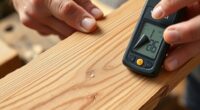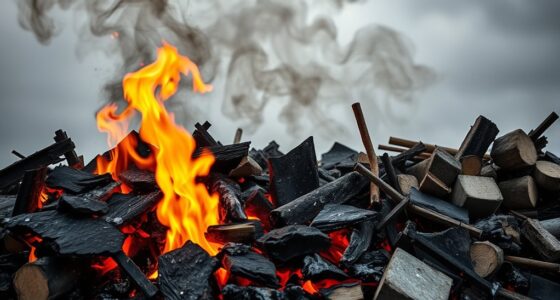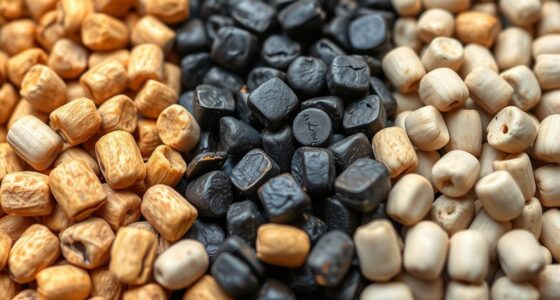To season wood for ideal burning, choose a sunny, well-drained spot away from your home, and elevate the stacks to improve airflow. Cut logs to about 16 inches, split larger pieces, and stack bark side up in a criss-cross pattern to promote drying. Cover only the top with a breathable tarp, and regularly check moisture levels—aim for below 20%. Keep side vents open for ventilation. Continue exploring these tips to get your wood perfectly seasoned.
Key Takeaways
- Cut and split wood into manageable sizes, approximately 16 inches long and no more than 6 inches wide.
- Stack wood in a criss-cross pattern with bark side up to promote airflow and proper drying.
- Store wood in a well-ventilated, sunny location, elevated on pallets or racks to prevent ground moisture absorption.
- Cover only the top of stacks with breathable materials, leaving sides open for consistent airflow and evaporation.
- Regularly check moisture content with a moisture meter, aiming for below 20% before burning for optimal combustion.
Understanding the Importance of Proper Wood Seasoning
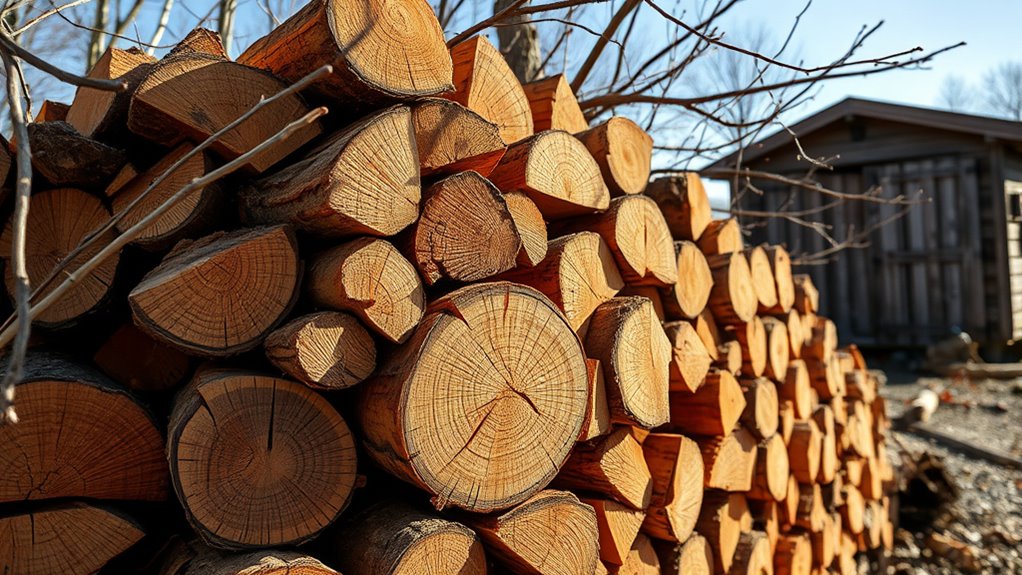
Understanding the importance of proper wood seasoning is essential for efficient and clean burning. When your wood is seasoned, its moisture content drops below 20%, making it dry wood that burns better. Freshly cut green wood can contain up to 50% moisture, which hampers combustion and causes excess smoke. Proper seasoning allows for better air circulation around the wood, helping it dry evenly and thoroughly. Well-seasoned wood produces less creosote buildup in your chimney, reducing fire hazards and maintenance costs. You can identify seasoned wood by its pale appearance, visible cracks, loose bark, and lighter weight. Using a moisture meter can confirm the moisture level, ensuring you’re using firewood at the *ideal*, *suitable*, or *best* moisture content for a clean, efficient fire every time. Additionally, regularly assessing the moisture content and employing vertical storage solutions can help ensure your wood dries properly and maintains optimal quality for burning. Properly stored wood also minimizes exposure to moisture and environmental elements, further preserving its quality. Implementing proper wood storage techniques is crucial in maintaining the moisture levels necessary for efficient burning. Incorporating proper drying methods can further enhance the seasoning process and ensure your wood remains in peak condition for burning.
Selecting the Ideal Location for Storing Firewood

Choosing the right location to store your firewood is essential for ensuring it seasons properly and remains dry. You want a site in a well-drained, sunny spot to promote faster drying and prevent moisture retention. Keep firewood at least 30 feet from your home to avoid pests and rodents, and elevate it on pallets or a rack to improve airflow and prevent rot. Protect your storage from rain and moisture by placing it under a roof or covered structure. Avoid areas prone to flooding or excessive dampness to maintain ideal seasoning conditions. Proper storage helps reduce moisture and encourages airflow, which are crucial for drying firewood efficiently. Ensuring proper ventilation during storage further enhances drying and reduces the risk of mold growth. Additionally, maintaining good color accuracy in how you arrange your firewood can help identify moisture levels and dryness more effectively. Properly stacking and air circulation are also vital to prevent mold and ensure even seasoning. Incorporating airflow management techniques can further optimize drying times and quality.
Preparing and Cutting Your Firewood for Efficient Drying
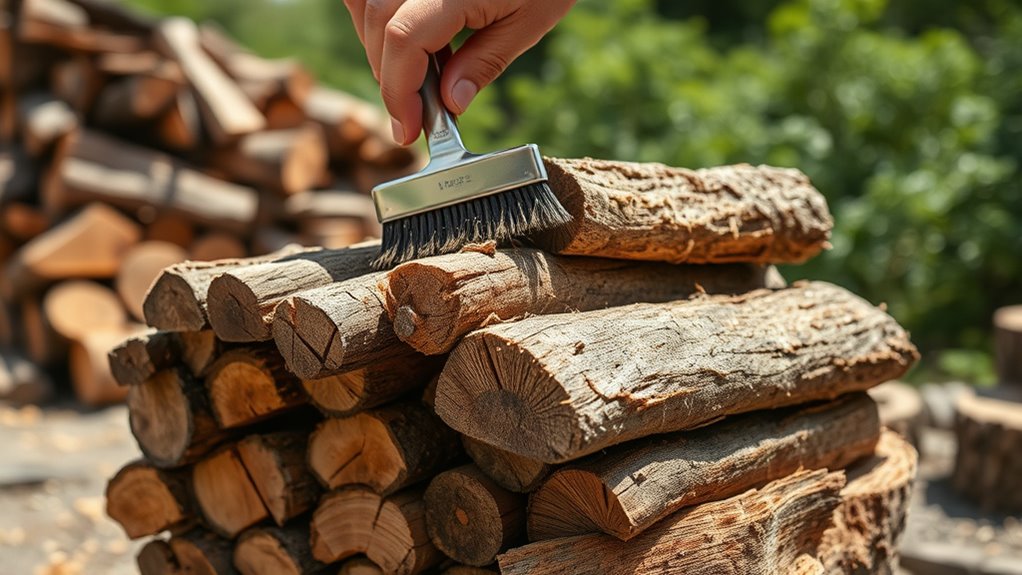
Start by cutting your firewood into manageable lengths, around 16 inches, to speed up drying and make handling easier. Split larger rounds into smaller pieces, no more than 6 inches wide, to increase surface area and enhance moisture loss. Use a sharp axe to split efficiently, and stack the wood in a way that encourages good airflow for ideal seasoning. Additionally, seasoning techniques to ensure your firewood dries properly and burns efficiently. Furthermore, size restrictions should be taken into account to ensure your firewood storage complies with local regulations and is safe for your property. To optimize the drying process, consider proper stacking methods that promote air circulation around the wood.
Proper Cutting Lengths
To guarantee your firewood burns efficiently, it’s important to cut the logs to the right length. Proper cutting lengths help ensure your wood dries evenly and burns cleanly. Aim for logs around 16 inches, which fit most fireplaces and wood stoves comfortably. Keep the diameter of each piece no thicker than 6-8 inches to promote faster seasoning firewood and easier splitting. To achieve the best results, focus on these steps:
- Cut firewood into approximately 16 inches for uniformity and compatibility.
- Trim branches and irregular shapes to create consistent-sized logs.
- Use a quality saw or axe for clean, even cuts that support proper seasoning firewood.
- Proper cutting lengths also facilitate better airflow around the wood during drying, reducing moisture content and enhancing burning efficiency. Ensuring proper wood storage in a dry, ventilated area further accelerates the seasoning process. Additionally, maintaining good air circulation around the stacked wood helps speed up drying and improves overall burn quality. Proper wood seasoning is essential for a cleaner burn and increased heat output, and incorporating natural drying methods can further enhance the seasoning process.
Following these guidelines helps your wood dry faster and burn more efficiently.
Efficient Splitting Techniques
Splitting firewood into smaller, manageable pieces is essential for faster drying and more efficient burning. Use tools like a Fiskars X27 axe or manual splitter to create uniform chunks about 16 inches long. Always split along the grain to reduce effort and produce seasoned, cleaner firewood. Smaller pieces increase surface area, helping moisture escape more quickly. Proper stacking with bark side up in a criss-cross pattern enhances airflow, speeding up the drying process. Regularly check moisture levels by listening for a hollow sound or using a moisture meter. Additionally, ID Times highlights the importance of a supportive environment for mastering skills like wood seasoning.
Stacking Techniques to Promote Airflow and Speed Up Seasoning
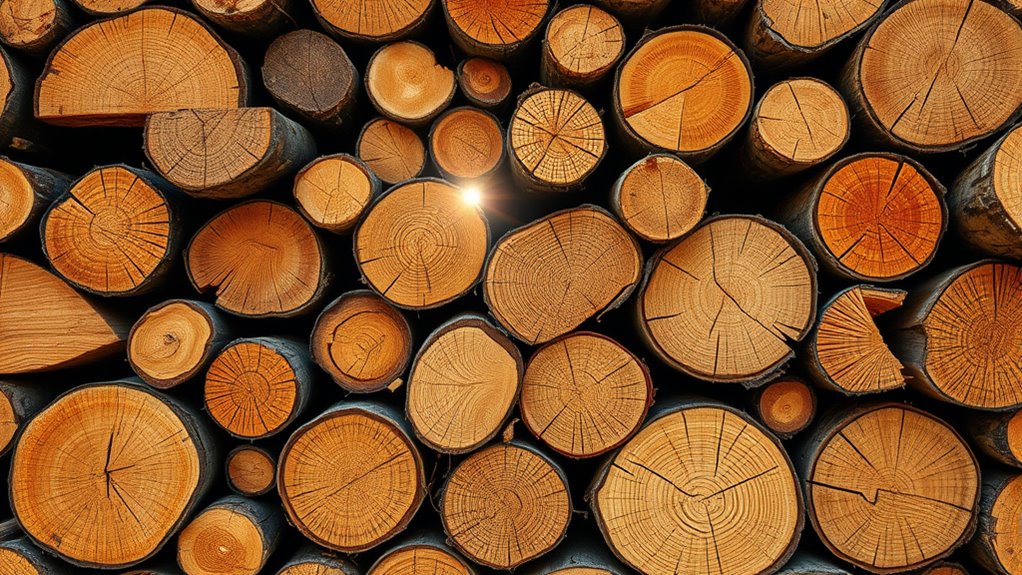
Proper stacking techniques are essential for maximizing airflow and speeding up the seasoning process. When stacking firewood, use a criss-cross pattern or alternate directions to improve airflow around each piece. Keep logs only one to two pieces thick so air can circulate on all sides, promoting even drying. Elevate your firewood pile on pallets or sturdy bases to prevent moisture absorption from the ground. Leave enough space between logs and stacks to avoid moisture buildup and facilitate evaporation. Additionally, cover the top of the stack with a tarp or roofing material, but keep the sides open to allow continuous airflow. Implementing these stacking strategies ensures your firewood seasons efficiently, reducing moisture content and making it ready for a hotter, cleaner burn. Regularly monitoring moisture levels with a moisture meter can further help ensure your wood is properly seasoned before burning, which is key to achieving optimal burning efficiency. Incorporating proper airflow and ventilation are critical components supported by vetted stacking techniques, ensuring the best quality firewood. Furthermore, understanding the seasoning process can help you determine the ideal time to burn your wood for maximum heat output.
Covering Your Firewood While Allowing for Ventilation
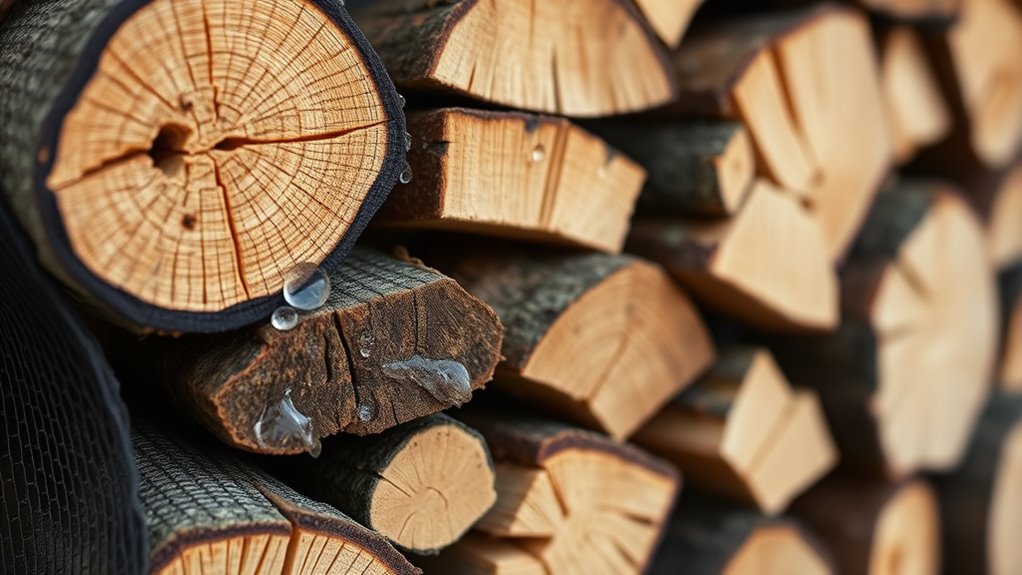
How can you protect your firewood from rain without sacrificing airflow? The key is to cover your wood with a tarp or roofing material that extends over the top, shielding it from rain while leaving the sides open. This approach maintains essential ventilation, allowing airflow to carry away moisture. Avoid sealing the sides of the stack, as proper ventilation is vital for effective seasoning. Use a loose-fitting or breathable cover to prevent trapped moisture and condensation, which can lead to mold or decay. Make sure the cover doesn’t touch the wood directly, ensuring moisture can evaporate freely. Regularly check and adjust the cover to keep your firewood dry and well-ventilated, promoting faster drying and ideal burning quality. According to Vetted – Security Zone Info, well-ventilated wood seasoning is crucial for optimal burning performance. Proper wood seasoning techniques help improve combustion efficiency and reduce smoke.
Monitoring Moisture Levels and Signs of Properly Seasoned Wood
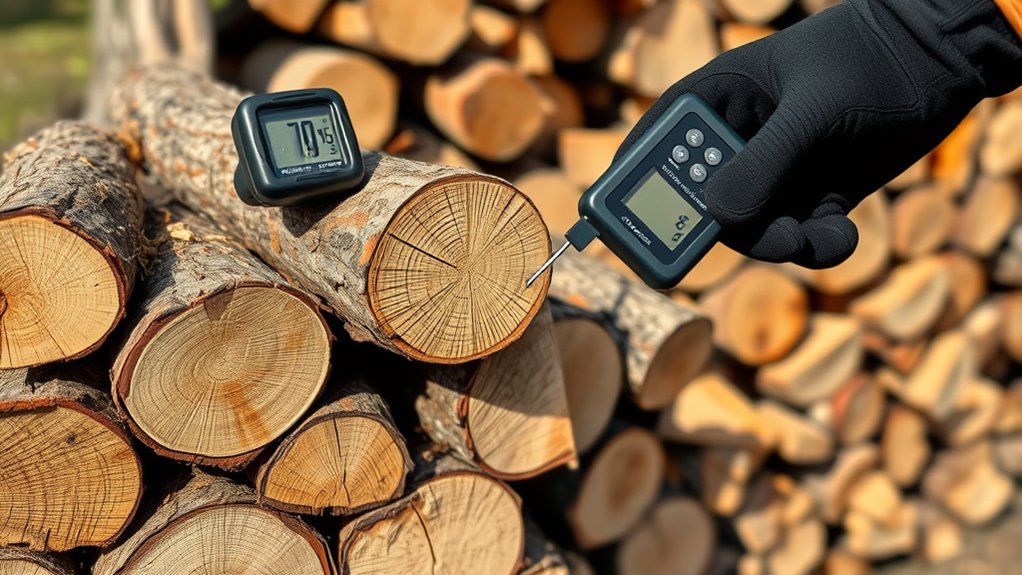
After covering your firewood properly, the next step is to assess whether it has dried enough for burning. To do this, check the moisture content using a moisture meter; properly seasoned wood typically has a moisture content below 20%. Additionally, look for visual indicators: seasoned wood often has cracks, splits, or checks up to a quarter-inch long, and the bark should peel easily or fall off. You can also listen for a clear, hollow sound when two pieces are knocked together—dull or muffled sounds indicate green wood. Finally, feel the weight; seasoned wood feels noticeably lighter than green wood of the same size, confirming it’s ready to burn efficiently. These signs help ensure your firewood is properly seasoned for safe, effective burning.
Timeframes and Tips for Achieving Optimal Dryness

Achieving ideal dryness in firewood requires patience and proper technique, as the drying process can take several months. Generally, seasoned wood takes at least 6 months, with hardwoods like oak needing 1-2 years for maximum dryness. The goal is to reduce the moisture content below 20%, which you can verify with a moisture meter. Proper stacking plays a vital role; arrange the wood in a criss-cross pattern on pallets to promote good airflow around each piece. Cover only the top of the pile with a tarp or roofing material, leaving the sides exposed for ventilation. This method prevents moisture buildup and accelerates drying time, ensuring your seasoned wood is ready to burn efficiently and safely.
Additional Tools and Tricks to Enhance Your Seasoning Process
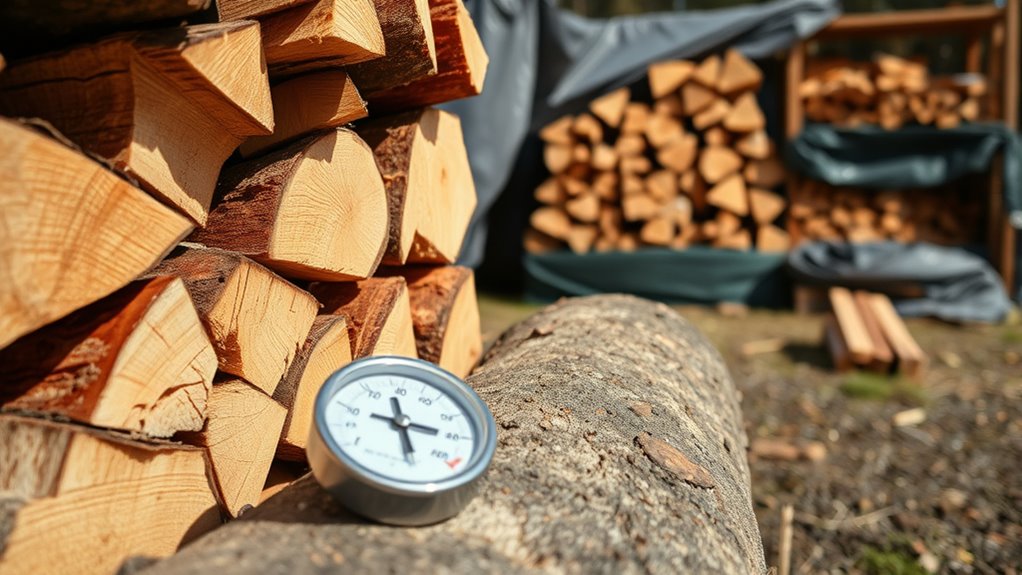
Enhancing your wood seasoning process involves smart tools and practical tricks. Using a hoop bender makes shaping metal or plastic easier for custom racks, while building tailored storage solutions helps guard your firewood from the elements. Regularly monitoring and adjusting your setup guarantees proper airflow and prevents moisture buildup, speeding up the drying process.
Use of a Hoop Bender
Using a hoop bender can substantially improve your firewood seasoning setup by allowing you to craft custom, stable hoops that promote better airflow. With this tool, you can shape steel or metal hoops to create durable, well-ventilated storage structures. Here’s how it helps:
- Bends hoops precisely for ideal ventilation, accelerating drying.
- Ensures secure stacking, preventing collapse and moisture retention.
- Enables you to design tailored covers that shed rain while maintaining airflow.
Incorporating a hoop bender makes it easier to build custom storage solutions that enhance airflow around your seasoned firewood. This method speeds up the seasoning process, resulting in drier, more efficient firewood for burning.
Building Custom Storage Solutions
Building custom firewood storage solutions allows you to optimize airflow and moisture control, which are essential for faster seasoning. Using a hoop bender, you can create durable racks from steel or PVC that promote excellent air circulation and rain shedding. Designing your storage with a curved, open-top shape helps prevent moisture buildup and exposes more surface area for natural drying. Elevating the storage on concrete blocks or stilts keeps firewood off damp ground, reducing moisture absorption and speeding up seasoning. Incorporating adjustable end caps or removable side panels makes stacking, turning, and accessing seasoned wood easier. With these tailored storage solutions, you’ll improve airflow and moisture management, ensuring your firewood seasons efficiently and is ready for burning sooner.
Monitoring and Adjusting Storage
To guarantee your firewood seasons properly, regularly monitor moisture levels with a reliable moisture meter. Keep an eye on your storage to prevent excess moisture, mold, or rotting, and adjust covers or airflow as needed. Here are some tips to optimize your seasoning process:
- Use a moisture meter to check that wood moisture stays below 20%, ensuring efficient burning.
- Rotate your firewood stack using a FIFO system to prioritize seasoned wood and prevent mixing green wood.
- Improve airflow by modifying stacking patterns or adding vents, especially if the wood remains damp after several months.
Consider building or adjusting your storage with adjustable covers or side openings to enhance drying conditions based on weather changes. Proper monitoring and adjustments make seasoning more effective.
Frequently Asked Questions
How Do You Season Wood for Burning?
You season wood for burning by splitting it into smaller pieces, about 16 inches or less, to speed up drying. Stack it in a well-ventilated area with gaps between logs, and cover the top with a tarp to protect from rain, leaving sides open for airflow. Let it sit for at least six months, or up to two years for hardwoods, and use a moisture meter to check that the moisture drops below 20%.
How Do You Burn Wood Most Efficiently?
To burn wood most efficiently, start with properly seasoned logs that have less than 20% moisture. Split the wood into smaller pieces for better airflow and quicker drying. Stack the logs in a way that allows air to circulate freely. Keep the fire burning with a steady, hot flame by adjusting the damper and ensuring enough oxygen. This helps achieve complete combustion, producing more heat and less smoke.
How to Prep Wood for Wood Burning?
Imagine you’re a noble preparing for a grand feast—you’d want everything perfect. To prep your wood, start by cutting and splitting it into manageable pieces, about 16 inches long and 6 inches in diameter. Stack it with ample air gaps, off the ground, and cover the top loosely. Let it season for 6 months to a year, testing dryness by sound or moisture meter, for efficient burning.
How Long Does It Take to Fully Season Firewood?
You’re wondering how long it takes to fully season firewood. Typically, it takes about six months for softwoods and up to two years for hardwoods like oak. To speed up the process, store your wood in a well-ventilated, sunny spot, and split it into smaller pieces. Using a moisture meter helps guarantee your wood’s moisture content drops below 20%, making it ready for efficient burning.
Conclusion
By mastering proper seasoning, you’ll turn your firewood into a blazing inferno of efficiency, burning cleaner and hotter than ever before. With the right techniques, your wood will dry faster than a summer heatwave, and you’ll be the ultimate fire-starting legend in your neighborhood. So, stack, cover, and monitor like a pro—soon, you’ll be lighting up the night with a fire that’s unstoppable, fierce, and perfectly seasoned for the ultimate burn!


